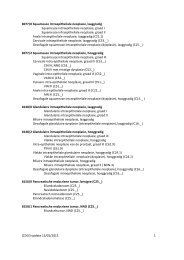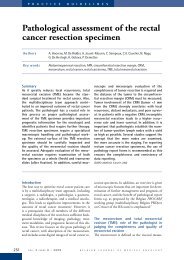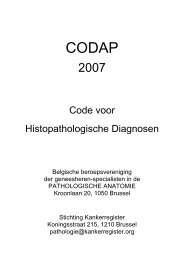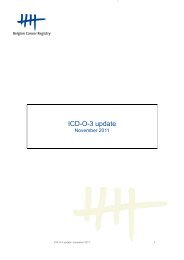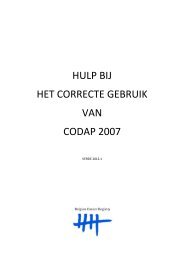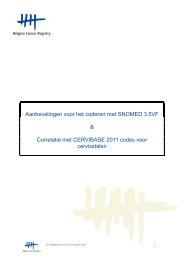Assurance de qualité pour le cancer rectal – phase 2 ...
Assurance de qualité pour le cancer rectal – phase 2 ...
Assurance de qualité pour le cancer rectal – phase 2 ...
You also want an ePaper? Increase the reach of your titles
YUMPU automatically turns print PDFs into web optimized ePapers that Google loves.
58 PROCARE <strong>–</strong> <strong>phase</strong> 2 KCE reports 81Exclusion:• patients not treated with TMERESULTSIn 30% of the PROCARE patients un<strong>de</strong>rgoing TME, the quality of TME was mentioned inthe pathology report (Tab<strong>le</strong> 51). For 76 of the 1058 patients that un<strong>de</strong>rwent surgery,no information was availab<strong>le</strong> on used surgical technique (total missings: 76/1071, 7%).Importantly, registration of the quality of TME only gradually started in November 2006.Therefore, the reported result is probably an un<strong>de</strong>restimation.This QI is measurab<strong>le</strong> for 56 centres using the prospective database. Five centres have ascore of 100%, whi<strong>le</strong> 26 centres score 0%. Twenty-four centres have a score above theweighted (30%; 95%CI 27 <strong>–</strong> 33%) and unweighted mean (29%; 95%CI 19 <strong>–</strong> 38%). For thecorrect interpretation of these results, risk-adjustment (tumour localisation, stage) isnecessary.No administrative co<strong>de</strong> exists for the result of a TME quality assessment, which in factis information that can only be retrieved from the medical fi<strong>le</strong> and theanatomopathological report. The QI is therefore not measurab<strong>le</strong> for the administrativecohort.Tab<strong>le</strong> 51. Quality of TME mentioned in the pathology report, measured withprospective PROCARE data.NPatients with <strong>rectal</strong> <strong>cancer</strong> 1071Proportion treated with surgery 1058Proportion treated with TME (<strong>de</strong>nominator) 833Porportion with quality of TME mentioned in the pathology report (numerator) 252 (30%)Distal tumour-free margin mentioned in the pathology reportDEFINITIONNumerator: all patients with RC that un<strong>de</strong>rwent sphincter saving surgery or Hartmann’sprocedure having their distal tumour-free margin mentioned in the pathology report.Denominator: all patients with RC that un<strong>de</strong>rwent sphincter saving surgery orHartmann’s procedure.Exclusion:• patients not treated with sphincter-sparing surgery or Hartmann’sprocedureRESULTSIn 89% of the PROCARE patients un<strong>de</strong>rgoing sphincter saving surgery or Hartmann’sprocedure the distal tumour-free margin is mentioned in the pathology report (Tab<strong>le</strong>52). For 51 of the 1058 patients un<strong>de</strong>rgoing surgery, no information was availab<strong>le</strong> onthe type of reconstruction. Above this, for 38 patients un<strong>de</strong>rgoing sphincter savingsurgery or Hartmann’s procedure, no pathology data were availab<strong>le</strong> (total missings:89/1071, 8%).This QI is measurab<strong>le</strong> for 53 centres using the prospective database. Twenty-threecentres have a score of 100%. Thirty-four centres have a score above the weighted(89%; 95%CI 87 <strong>–</strong> 92%) and unweighted mean (89%; 95%CI 84 <strong>–</strong> 94%). For the correctinterpretation of these results, risk-adjustment (tumour localisation) is necessary.No administrative co<strong>de</strong> exists for the distal tumour-free margin, which are also datathat can only be retrieved from the medical fi<strong>le</strong>. The QI is therefore not measurab<strong>le</strong> forthe administrative cohort.



